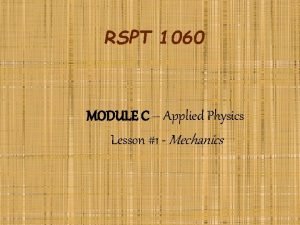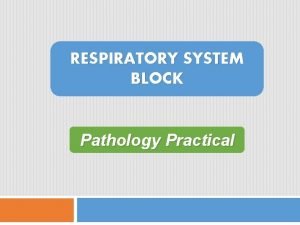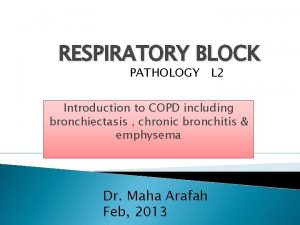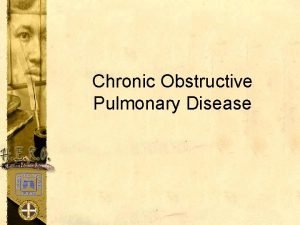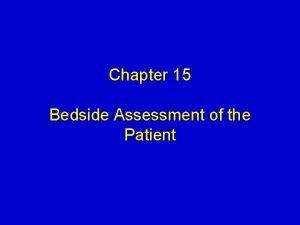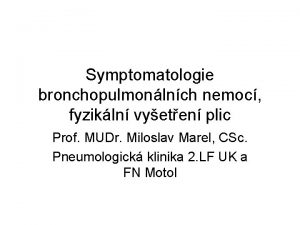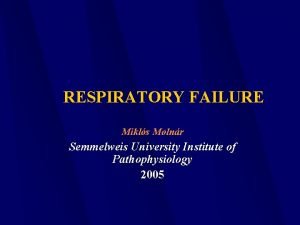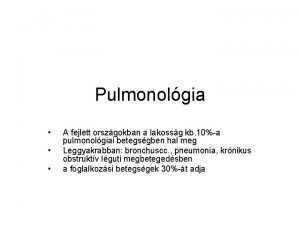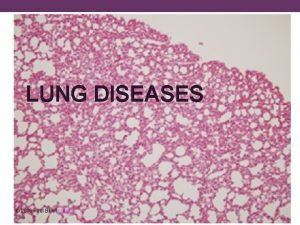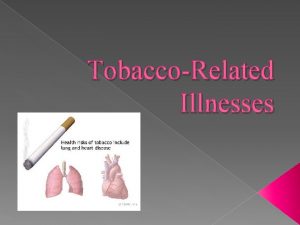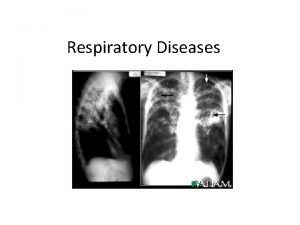EMPHYSEMA Dr V Harisankar Definition Emphysema is defined











- Slides: 11

EMPHYSEMA Dr. V Harisankar

Definition: Emphysema is defined as a pathological increase in the size of airspaces distal to the terminal bronchioles, with destruction of the alveolar walls.

ETIOLOGY Ø Diseases of the airways: Chronic bronchitis, prolonged exposure to irritants and dusts (heavy cigarette smoking), and chronic partial bronchial obstruction. Ø Conditions associated with alpha-1 antitrypsin deficiency. Ø Chronic bronchial asthma leads on to emphysema as a sequel.

Ø Several pneumoconioses give rise to emphysema as part of the pathological process or as compensatory Mechanism. Ø Occupational causes: Several occupations which require forced expiratory effort as seen in furnace blowers, goldsmiths, and users of wind instruments predispose to the development of emphysema in susceptible subjects. Ø Exposure to cadmium leads to the development of emphysema and pulmonary fibrosis.

PATHOLOGY: Ø The lungs are in the inflated position occupying the whole of the pleural cavity. Ø Since the elastic tissue is damaged, the lungs lose their elasticity and they fail to collapse when the chest is opened during autopsy. The diaphragm is depressed and respiratory excursions are diminished. Ø The alveoli are overdistended. Ø The septa rupture and neighbouring alveoli coalesce to form air cysts. Ø The pulmonary vascular bed is progressively diminished and pulmonary arterial hypertension results.

Ø Reduction of alveolar surface area leads to impairment of gas exchange. Ø Right ventricular hypertrophy and cor pulmonale may develop. Ø Emphysematous bullae may rupture to produce spontaneous pneumothorax.

CLINICAL FEATURES Ø The main symptom is exertional dyspnea. As the condition progresses, even ordinary activity like talking, eating or lying flat may cause dyspnea. Ø The chest is distended in the position of full inspiration. Ø Expansion is diminished and the accessory muscles of respiration are active. Ø Expiration becomes an active process due to loss of elasticity of the lung. Ø Infective episodes occur frequently.

Physical examination : Ø Barrel-shaped chest with diminished expansion, hyperresonance on percussion, obliteration of cardiac and liver dullness and diminished breath sounds with prolonged expiration. Ø Due to increased intrathoracic pressure especially during expiration, the neck veins become distended during expiration and collapse during inspiration. Ø The apex beat is felt feebly because of interposition of the distended lung. Ø Right ventricular hypertrophy produces a heaving impulse in the epigastrium and subxiphoid region.

Ø Left parasternal heave may not be evident on account of the inflated lung covering the heart. Special Forms of Emphysema Compensatory emphysema: Ø This is the condition in which the normal lung tissue undergoes hypertrophy to compensate for extensive damage to the other lung or other parts of the same lung. Ø Being a compensatory phenomenon, this is asymptomatic. Ø The respiratory excursion of the normal lung is increased in this case.

Atrophic emphysema: Ø This condition is the result of senile atrophy of inter-alveolar septa. Ø The total lung volume is not increased. Bullous emphysema: Ø In this condition air spaces exceeding 1 cm in diameter develop either congenitally or as a part of acquired generalized emphysema. Ø With passage of time these bullae enlarge and become giant bullous emphysema.

Ø They may rupture toproducepneumothorax. Ø At times the bullae may get infected to produce abscesses.

